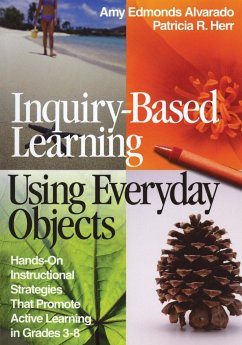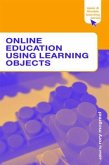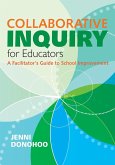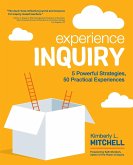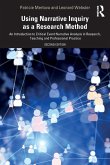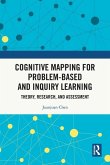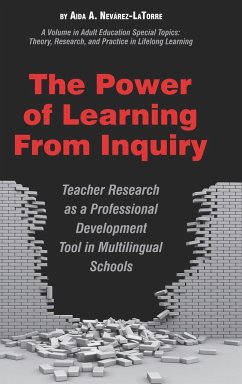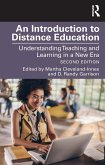Amy Edmonds Alvarado, Patricia R. Herr
Inquiry-Based Learning Using Everyday Objects
Hands-On Instructional Strategies That Promote Active Learning in Grades 3-8
Amy Edmonds Alvarado, Patricia R. Herr
Inquiry-Based Learning Using Everyday Objects
Hands-On Instructional Strategies That Promote Active Learning in Grades 3-8
- Broschiertes Buch
- Merkliste
- Auf die Merkliste
- Bewerten Bewerten
- Teilen
- Produkt teilen
- Produkterinnerung
- Produkterinnerung
This exciting new book explores how students can use everyday objects to answer essential questions, meet curriculum standards, and grow in observation, inquisitiveness, and reflective learning.
Andere Kunden interessierten sich auch für
![Online Education Using Learning Objects Online Education Using Learning Objects]() Rory McGreal (ed.)Online Education Using Learning Objects48,99 €
Rory McGreal (ed.)Online Education Using Learning Objects48,99 €![Collaborative Inquiry for Educators Collaborative Inquiry for Educators]() Jenni Anne Marie DonohooCollaborative Inquiry for Educators34,99 €
Jenni Anne Marie DonohooCollaborative Inquiry for Educators34,99 €![Experience Inquiry Experience Inquiry]() Kimberly L. MitchellExperience Inquiry43,99 €
Kimberly L. MitchellExperience Inquiry43,99 €![Using Narrative Inquiry as a Research Method Using Narrative Inquiry as a Research Method]() Patricie MertovaUsing Narrative Inquiry as a Research Method59,99 €
Patricie MertovaUsing Narrative Inquiry as a Research Method59,99 €![Cognitive Mapping for Problem-based and Inquiry Learning Cognitive Mapping for Problem-based and Inquiry Learning]() Juanjuan ChenCognitive Mapping for Problem-based and Inquiry Learning62,99 €
Juanjuan ChenCognitive Mapping for Problem-based and Inquiry Learning62,99 €![The Power of Learning from Inquiry The Power of Learning from Inquiry]() Aida A. Nevarez-LatorreThe Power of Learning from Inquiry106,99 €
Aida A. Nevarez-LatorreThe Power of Learning from Inquiry106,99 €![An Introduction to Distance Education An Introduction to Distance Education]() An Introduction to Distance Education81,99 €
An Introduction to Distance Education81,99 €-
-
-
This exciting new book explores how students can use everyday objects to answer essential questions, meet curriculum standards, and grow in observation, inquisitiveness, and reflective learning.
Hinweis: Dieser Artikel kann nur an eine deutsche Lieferadresse ausgeliefert werden.
Hinweis: Dieser Artikel kann nur an eine deutsche Lieferadresse ausgeliefert werden.
Produktdetails
- Produktdetails
- Verlag: SAGE Publications Inc
- Seitenzahl: 216
- Erscheinungstermin: 17. April 2003
- Englisch
- Abmessung: 254mm x 178mm x 12mm
- Gewicht: 384g
- ISBN-13: 9780761946809
- ISBN-10: 0761946802
- Artikelnr.: 21265850
- Herstellerkennzeichnung
- Libri GmbH
- Europaallee 1
- 36244 Bad Hersfeld
- gpsr@libri.de
- Verlag: SAGE Publications Inc
- Seitenzahl: 216
- Erscheinungstermin: 17. April 2003
- Englisch
- Abmessung: 254mm x 178mm x 12mm
- Gewicht: 384g
- ISBN-13: 9780761946809
- ISBN-10: 0761946802
- Artikelnr.: 21265850
- Herstellerkennzeichnung
- Libri GmbH
- Europaallee 1
- 36244 Bad Hersfeld
- gpsr@libri.de
Amy Alvarado has thirteen years experience in the classroom and extensive expertise in helping educators improve instructional techniques and curriculum design in all content areas. She has an undergraduate degree in English and secondary education from the College of William and Mary and a masters degree in Educational Psychology with a specialization in gifted education from the University of Virginia. She is currently a doctoral candidate in Curriculum and Instruction at the University of Virginia.
Acknowledgments About the Authors Dedication Introduction: Welcome to Inquiry-Based Learning Using Everyday Objects (Object-Based Inquiry) Part I. Object-Based Learning 1. What Is Object-Based Inquiry? The Reality of Object-Based Learning Why Use Object-Based Inquiry? Time to Begin Your Journey 2. How Do I Gather Collections? Getting Started Expanding Your Collection Storing Your Collections 3. How Do I Get Started? Planning the Classroom Grouping Your Students Planning Your Lessons Avoiding the Pitfalls Benefits Roles of the Teacher and Students 4. Where Do I Start With Planning? Things to Consider Step One: Developing Essential Understandings Step Two: Identifying Specific Objectives Step Three: Locating the Objects Step Four: Question Development Conclusion 5. How Do I Assess? Formative Assessment Summative Assessment Part II. Lesson Plans 6. Language Lesson Plans Why Do Tigers Have Stripes? What Makes a Poem Perfect? She Sells Sea Shells What
s Your Fantasy? 7. Science Lesson Plans Zone Home Birds of a Feather Whose Track Is That? Science Rocks 8. Social Studies Lesson Plans I
m a Mystery: What
s My History Can You Dig History? Where in America Are You? Flower Power 9. Math Lesson Plans Measuring Madness Architectural Geometry What
s For Dinner? What Part of Fractions Is Difficult? Glossary Index
s Your Fantasy? 7. Science Lesson Plans Zone Home Birds of a Feather Whose Track Is That? Science Rocks 8. Social Studies Lesson Plans I
m a Mystery: What
s My History Can You Dig History? Where in America Are You? Flower Power 9. Math Lesson Plans Measuring Madness Architectural Geometry What
s For Dinner? What Part of Fractions Is Difficult? Glossary Index
Acknowledgments About the Authors Dedication Introduction: Welcome to Inquiry-Based Learning Using Everyday Objects (Object-Based Inquiry) Part I. Object-Based Learning 1. What Is Object-Based Inquiry? The Reality of Object-Based Learning Why Use Object-Based Inquiry? Time to Begin Your Journey 2. How Do I Gather Collections? Getting Started Expanding Your Collection Storing Your Collections 3. How Do I Get Started? Planning the Classroom Grouping Your Students Planning Your Lessons Avoiding the Pitfalls Benefits Roles of the Teacher and Students 4. Where Do I Start With Planning? Things to Consider Step One: Developing Essential Understandings Step Two: Identifying Specific Objectives Step Three: Locating the Objects Step Four: Question Development Conclusion 5. How Do I Assess? Formative Assessment Summative Assessment Part II. Lesson Plans 6. Language Lesson Plans Why Do Tigers Have Stripes? What Makes a Poem Perfect? She Sells Sea Shells What
s Your Fantasy? 7. Science Lesson Plans Zone Home Birds of a Feather Whose Track Is That? Science Rocks 8. Social Studies Lesson Plans I
m a Mystery: What
s My History Can You Dig History? Where in America Are You? Flower Power 9. Math Lesson Plans Measuring Madness Architectural Geometry What
s For Dinner? What Part of Fractions Is Difficult? Glossary Index
s Your Fantasy? 7. Science Lesson Plans Zone Home Birds of a Feather Whose Track Is That? Science Rocks 8. Social Studies Lesson Plans I
m a Mystery: What
s My History Can You Dig History? Where in America Are You? Flower Power 9. Math Lesson Plans Measuring Madness Architectural Geometry What
s For Dinner? What Part of Fractions Is Difficult? Glossary Index

